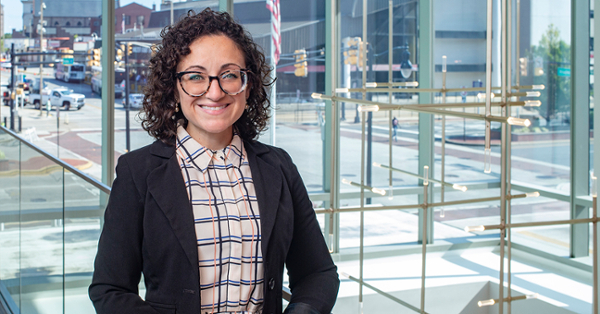Improving the accuracy of physical activity measurement in research
Improving the accuracy of physical activity measurement in research

Women between the ages of 40 and 60 face unique life and health challenges, from caretaking for children and older parents to a greater risk for heart disease, which increases dramatically as women reach menopause. Women in this age range also experience a decrease in physical activity not seen in men of the same age, said Danielle Arigo, Ph.D., an associate professor of psychology in the College of Science & Mathematics.
Now, with a new grant from the National Institutes of Health (NIH), Arigo is continuing her NIH-funded research to understand barriers to physical activity, as well as effective ways to promote physical activity in this population.
Arigo’s latest study, “Predictors of Reactivity to Physical Activity Measurement among Women in Midlife with Elevated CVD Risk: Examination Across 7 Studies,” builds on another ongoing NIH-funded project in which Arigo and Dr. Andrea Lobo (Rowan University Department of Computer Science) designed and tested tailored physical activity interventions for women in midlife using digital health tools like websites and mobile apps. It also extends directly from Arigo’s work with Germany’s Bayreuth Humboldt Centre for International Excellence, in collaboration with Dr. Laura König (University of Bayreuth).
Now, Arigo aims to determine how the introduction of physical activity monitoring as part of a research study impacts the amount of physical activity a person performs. For example, many studies ask people to wear a Fitbit or pedometer and to answer questions about their physical activity for several days in a row.
“If you’re not used to wearing a physical activity monitor (or to thinking about your physical activity throughout the day), starting to wear a monitor and knowing that you’re in a study can actually change your behavior temporarily,” Arigo said. “It's not clear how long the effect lasts. It's not clear for whom it's most powerful. If part of what you're capturing is this reaction to the introduction of measurement, you're potentially biasing your entire evaluation because you're going to have elevation in physical activity on the first day or two.”
This temporary elevation in activity can skew research data—but by how much? To determine the impact of wearing a physical activity monitor as part of the research study, Arigo will evaluate seven data sets. Some sets of data are publicly available and nationally representative, like the National Health Examination Survey, and others come from clinical trials at universities like Drexel and Penn State.
By looking into these numbers more deeply, Arigo will be able to measure the difference in activity from the first days of the study through the end. Then, she will determine whether specific situations produce more of a reactivity effect—like certain devices, certain research contexts, or more motivated people.
Once Arigo is able to determine how much more activity people perform during the early days of activity monitoring, then she can make recommendations for mitigating the effect if it is negatively impacting conclusions from the research.
“The ultimate goal is to figure out if it's a problem,” Arigo said, “and if it is, how to prevent it from happening or addressing it on the back end, statistically, in your analyses.”
Arigo hypothesizes one such recommendation might be educating study participants of the likelihood that wearing a physical activity monitor can change their behavior.
“We hope that this can generate some interest for this population and the way that we measure their behavior in these kinds of studies,” Arigo said, “but also the way we talk to them about their participation in these kinds of studies or their participation in community-based physical activity programs. The biggest real-world implication is helping people understand how they interact with devices and also interact with different contexts.”